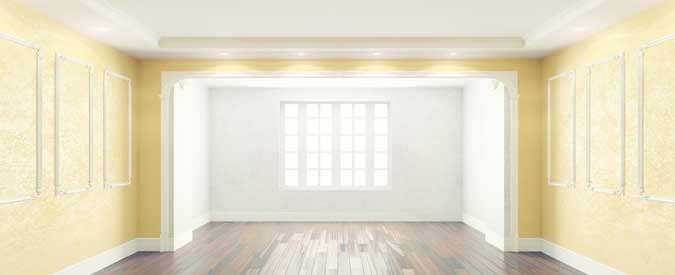Last Updated: February 15, 2023
Types of Interior Trim: Crown Moulding, Wainscoting, Case Moulding, Chair Rail and More
Try Our Free Interior Trim Cost Calculator
Fill out our 30 second free form to receive competitive pricing from pre-screened contractors. No commitments. Our service is always free!
Interior trim work makes a home look more elegant and polished. Chances are, your home already has basic baseboard and doorway trim. But you can improve the look by adding features such as crown moldings, chair rails or wainscoting.
Here are descriptions of the most popular choices for interior trim:
- Crown molding - A decorative trim that covers the area where the walls meet the ceiling. It is available in a variety of materials, including polystyrene foam, medium-density fiberboard (MDF) and wood. Crown molding is also available in a variety of thicknesses, designs and finishes.
- Wainscoting - Panels of wood or other materials that cover the lower portion of a wall - often three to four feet. These panels often have tongue-and-groove slats or a recessed panel look, and they’re often topped by a chair rail. Wainscoting was originally invented to combat moisture problems, but today it is primarily decorative. Common materials include wood and vinyl.
- Case Molding - Used to trim doorways, windows and archways. These are placed where the door or window meets the drywall. They can made from a variety of materials, including wood and MDF, and the trim is generally thinner than you’ll see for base moldings.
- Chair Rails - Placed several feet above the baseboards where the top of a chair would hit the wall (hence, the name). Chair rails protect your walls from damage when chairs are scooted out, but they’re also popular as a decorative feature.
- Floor Molding - Much like crown molding visually, expect that it’s installed where the floor meets the drywall in place of basic baseboards. The look is fancier and more decorative than traditional baseboards.
- Molding Blocks - Decorative accent pieces placed where crown molding meets at the corners or where case molding meets at the corners. These add an extra decorative touch to your crown molding or case molding.

Try Our Free Interior Trim Cost Calculator
Fill out our 30 second free form to receive competitive pricing from pre-screened contractors. No commitments. Our service is always free!
Cost of Interior Trim
The cost of interior trim depends on many factors: the type and size of the trim, the materials used, the number of rooms where you plan to install trim and their size, the difficulty of the job (i.e. how many corners have to be cut), whether you need the trim stained or painted, and local labor rates (unless the job is DIY).
- Crown molding varies in price from about $3 to $20 per lineal foot installed. On the low end of that price range you’ll get polystyrene foam molding, which is inexpensive and easy to install. On the high end, you’ll get a high-end product made of exotic wood or a molding that has been custom designed. The average installed price for mid-grade wood is closer to $4 to $10 per lineal foot.
- Floor molding is similarly priced.
- Wainscoting usually costs anywhere from $15 to $40 per lineal foot installed, depending the material, height and local labor rates. Custom jobs with expensive wood fall on the high end of that price range. Vinyl wainscoting tends to fall on the lower end.
- Chair rails usually cost about $3 to $5 per linear foot installed.
- Molding blocks cost anywhere from $1 to $20 each, depending on quality and materials. The more ornate the block, the more expensive it will be. Not surprisingly, finished blocks cost more than unfinished blocks.
Choosing the Right Combination of Trim
Everyone’s tastes are different, but as a general rule you shouldn’t use more than two (or sometimes three) types of decorative trim in a single room. Crown molding and chair rails can look really good together, but add wainscoting or floor molding and you might be going overboard. There are no hard and fast rules, of course, but keep in mind that sometimes less is more. You can always go back and add another element later, but you don’t want to add too many elements at once and regret it.
If you’re unsure about what kind of trim to add or what looks best with what, consult a professional carpenter or trimming expert for advice. A pro can offer his or her opinion on what would work best in the room and give you a price quote.
Find the Best Interior Trim Pros Who Will Compete for Your Business
Try Our Free Interior Trim Cost Calculator
Fill out our 30 second free form to receive competitive pricing from pre-screened contractors. No commitments. Our service is always free!
Try Our Free Interior Trim Cost Calculator
Fill out our 30 second free form to receive competitive pricing from pre-screened contractors. No commitments. Our service is always free!